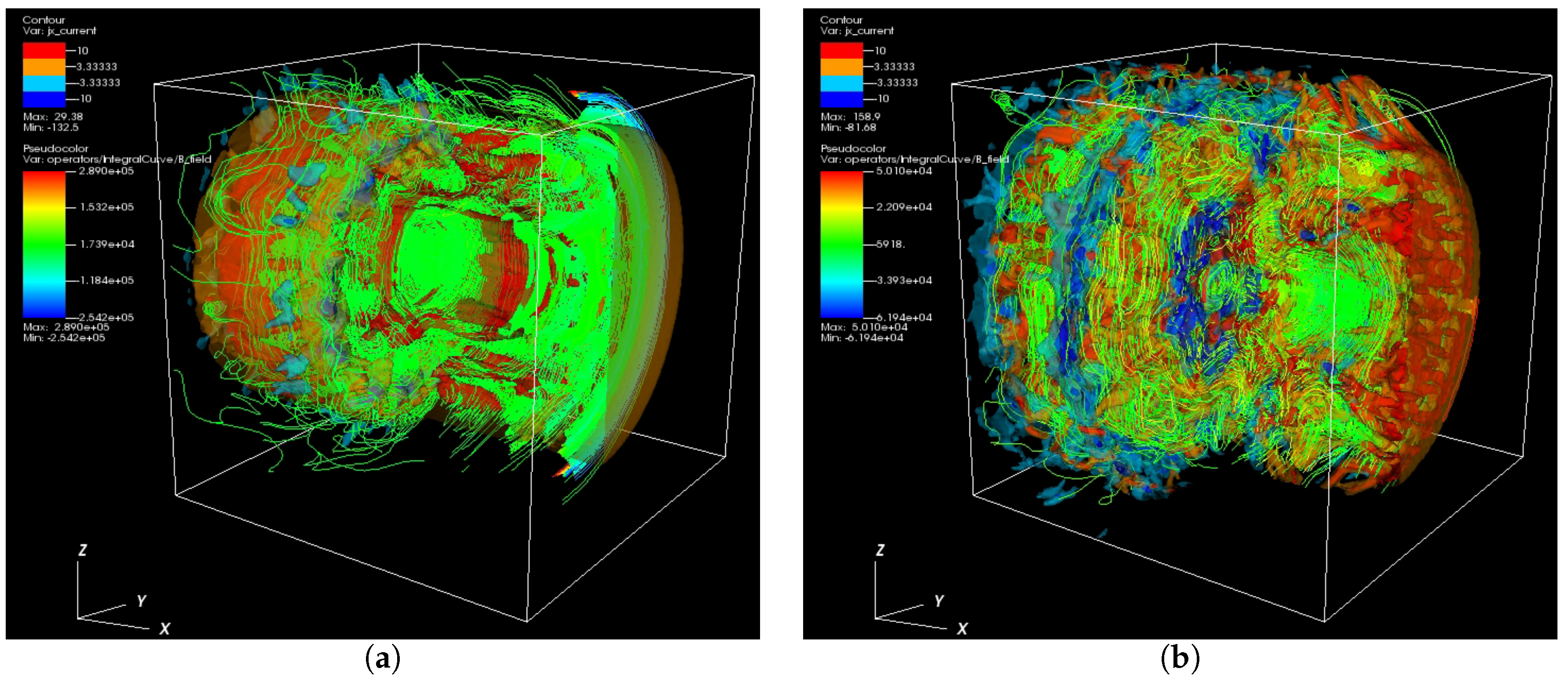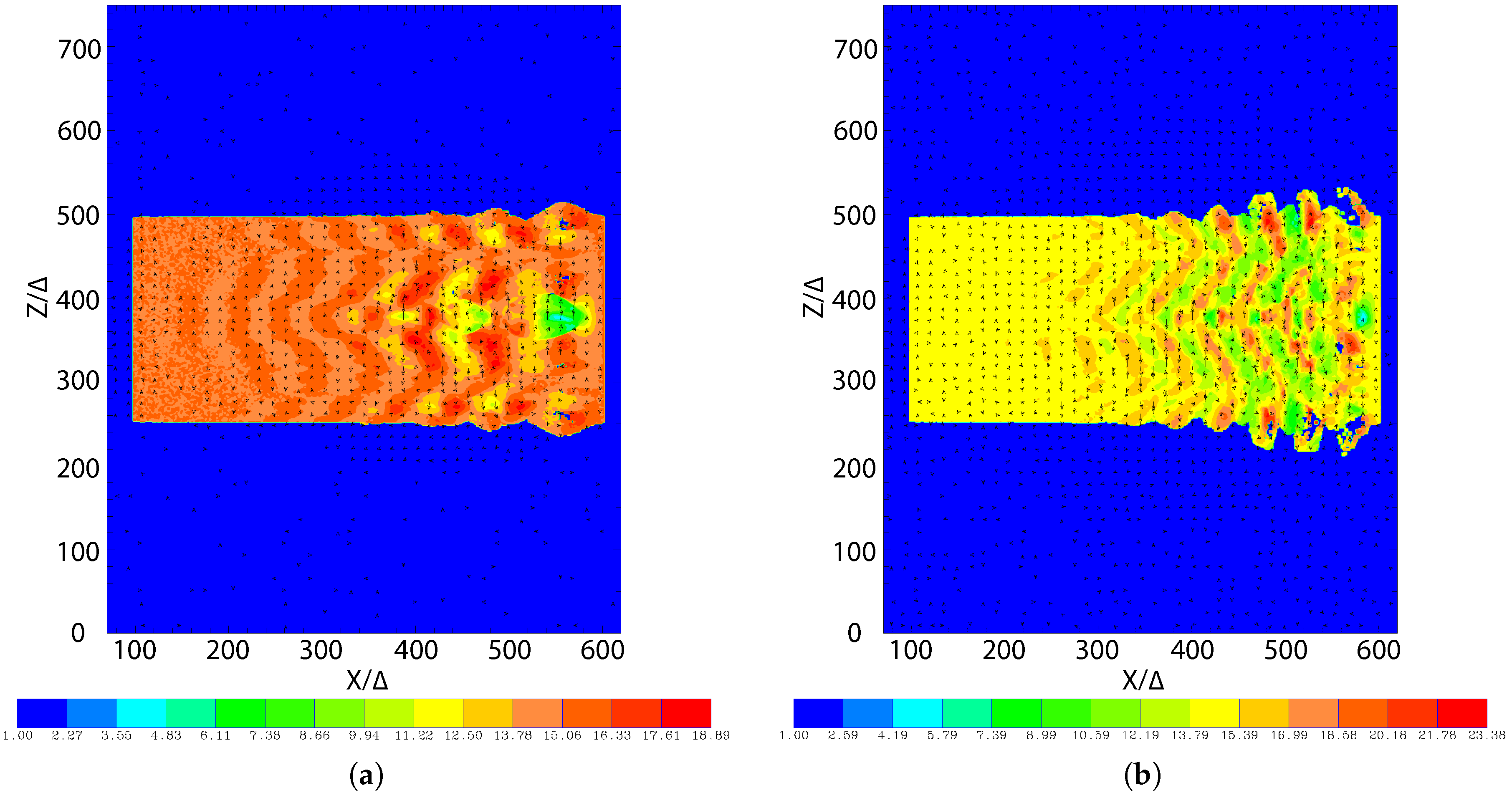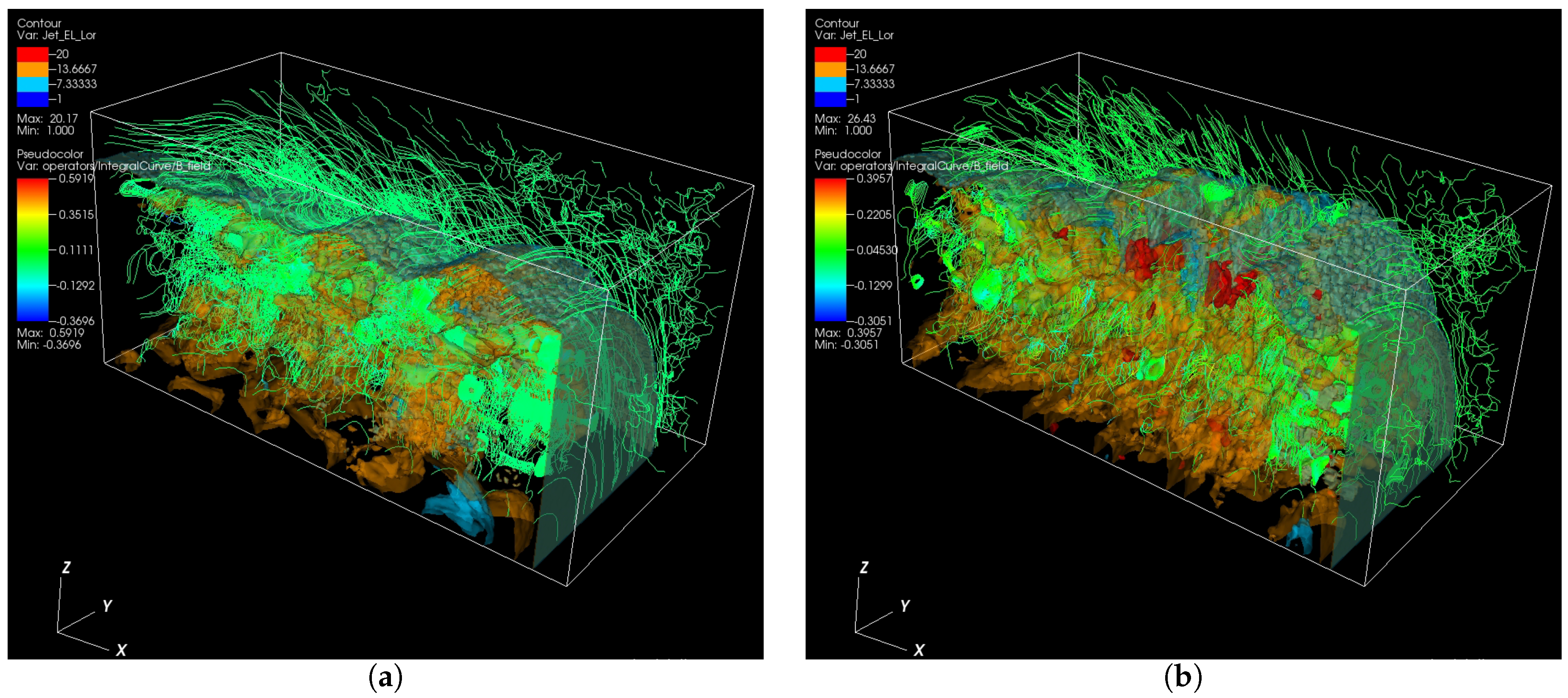Microscopic Processes in Global Relativistic Jets Containing Helical Magnetic Fields: Dependence on Jet Radius
Abstract
:1. Introduction
2. Simulation Setup
2.1. Helical Magnetic Field Structure
2.2. Magnetic Fields in Helically Magnetized RPIC Jets with Larger Jet Radius
3. Discussion
Supplementary Materials
Acknowledgments
Author Contributions
Conflicts of Interest
References
- Hawley, J.F.; Fendt, C.; Hardcastle, M.; Nokhrina, E.; Tchekhovskoy, A. Disks and Jets Gravity, Rotation and Magnetic Fields. Space Sci. Rev. 2015, 191, 441–469. [Google Scholar] [CrossRef]
- Pe’er, A. Energetic and Broad Band Spectral Distribution of Emission from Astronomical Jets. Space Sci. Rev. 2014, 183, 371–403. [Google Scholar] [CrossRef]
- Nicholas, R.; MacDonald, M.R.; Marscher, A.P. Faraday Conversion in Turbulent Blazar Jets. arXiv, 2016; arXiv:1611.09954. [Google Scholar]
- Nishikawa, K.-I.; Frederiksen, J.T.; Nordlund, Å.; Mizuno, Y.; Hardee, P.E.; Niemiec, J.; Gómez, J.L.; Pe’er, A.; Duţan, I.; Meli, A.; et al. Evolution of Global Relativistic Jets: Collimations and Expansion with kKHI and the Weibel Instability. Astrophys. J. 2016, 820, 94–107. [Google Scholar] [CrossRef]
- Nishikawa, K.-I.; Mizuno, Y.; Niemiec, J.; Kobzar, O.; Pohl, M.; Gómez, J.L.; Duţan, I.; Pe’er, A.; Frederiksen, J.T.; Nordlund, Å.; et al. Microscopic Processes in Global Relativistic Jets Containing Helical Magnetic Fields. Galaxies 2016, 4, 38. [Google Scholar] [CrossRef]
- Duţan, I.; Nishikawa, K.-I.; Mizuno, Y.; Niemiec, J.; Kobzar, O.; Pohl, M.; Gómez, J.L.; Pe’er, A.; Frederiksen, J.T.; Nordlund, A.; et al. Particle-in-cell Simulations of Global Relativistic Jets with Helical Magnetic Fields. New Front. Black Hole Astrophys. Proc. IAU Symp. 2017, 12, 199–202. [Google Scholar]
- Mizuno, Y.; Hardee, P.E.; Nishikawa, K.-I. Spatial Growth of the Current-Driven Instability in Relativistic Jets. Astrophys. J. 2014, 784, 167–182. [Google Scholar] [CrossRef]
- Singh, C.B.; Mizuno, Y.; de Gouveia Dal Pino, E.M. Spatial Growth of Current-driven Instability in Relativistic Rotating Jets and the Search for Magnetic Reconnection. Astrophys. J. 2016, 824, 48. [Google Scholar] [CrossRef]
- Barniol Duran, R.; Tchekhovskoy, A.; Giannios, D. Simulations of AGN jets: Magnetic kink instability versus conical shocks. Mon. Not. R. Astron. Soc. 2017, 469, 4957–4978. [Google Scholar] [CrossRef]
- Mizuno, Y.; Gómez, J.L.; Nishikawa, K.-I.; Meli, A.; Hardee, P.E.; Rezzolla, L. Recollimation Shocks in Magnetized Relativistic Jets. Astrophys. J. 2015, 809, 38. [Google Scholar] [CrossRef]
Sample Availability: Data (vtk) for VisIt and ParaView are available upon the request. |




© 2017 by the authors. Licensee MDPI, Basel, Switzerland. This article is an open access article distributed under the terms and conditions of the Creative Commons Attribution (CC BY) license (http://creativecommons.org/licenses/by/4.0/).
Share and Cite
Nishikawa, K.-I.; Mizuno, Y.; Gómez, J.L.; Duţan, I.; Meli, A.; White, C.; Niemiec, J.; Kobzar, O.; Pohl, M.; Pe’er, A.; et al. Microscopic Processes in Global Relativistic Jets Containing Helical Magnetic Fields: Dependence on Jet Radius. Galaxies 2017, 5, 58. https://doi.org/10.3390/galaxies5040058
Nishikawa K-I, Mizuno Y, Gómez JL, Duţan I, Meli A, White C, Niemiec J, Kobzar O, Pohl M, Pe’er A, et al. Microscopic Processes in Global Relativistic Jets Containing Helical Magnetic Fields: Dependence on Jet Radius. Galaxies. 2017; 5(4):58. https://doi.org/10.3390/galaxies5040058
Chicago/Turabian StyleNishikawa, Ken-Ichi, Yosuke Mizuno, Jose L. Gómez, Ioana Duţan, Athina Meli, Charley White, Jacek Niemiec, Oleh Kobzar, Martin Pohl, Asaf Pe’er, and et al. 2017. "Microscopic Processes in Global Relativistic Jets Containing Helical Magnetic Fields: Dependence on Jet Radius" Galaxies 5, no. 4: 58. https://doi.org/10.3390/galaxies5040058
APA StyleNishikawa, K.-I., Mizuno, Y., Gómez, J. L., Duţan, I., Meli, A., White, C., Niemiec, J., Kobzar, O., Pohl, M., Pe’er, A., Frederiksen, J. T., Nordlund, Å., Sol, H., Hardee, P. E., & Hartmann, D. H. (2017). Microscopic Processes in Global Relativistic Jets Containing Helical Magnetic Fields: Dependence on Jet Radius. Galaxies, 5(4), 58. https://doi.org/10.3390/galaxies5040058








